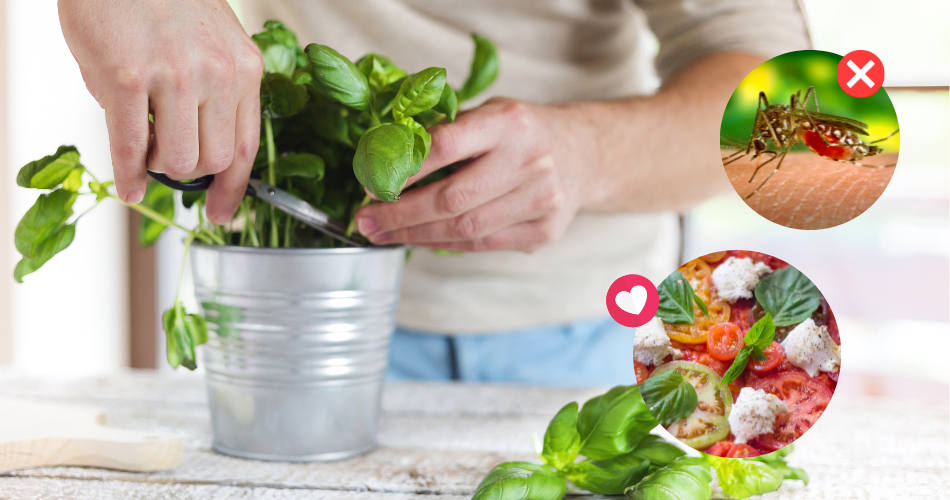
Basil is a popular seasoning herb used in many cuisines around the world. The plant is a member of the mint family and has a strong, pungent flavor. Basil is native to India and other tropical regions and quickly grows in warm climates. It’s also a major part of Italian cuisine. In fact, Italians adore basil so much that it became a symbol of love. The herb is used fresh or dried and is often added to tomato sauces, pesto, and other Italian dishes. If you want to grow basil, we have got some useful tips for you.
There are few herbs as versatile or easy to grow as basil. This sweet-smelling annual is a staple in many cuisines and can be used in everything from pesto to Caprese salad. If you’re thinking of growing your basil plants, here are some insights to get you started.
Types of Basil Plants

There are many different types of basil plants, and each one has its unique flavor and purpose. Each type of basil has a different flavor profile, so choose the right one for your dish.
- The most common type of basil is sweet basil, often used in Italian cuisine. Sweet basil has a mild, sweet flavor with tomatoes and other Italian staples.
- Thai basil has a more robust flavor that can stand up to spicy dishes.
- Holy basil has a strong, pungent flavor often used in Ayurvedic medicine.
- Lemon basil has a citrusy flavor that is perfect for summer dishes.
No matter which type of basil you choose, it will add delicious flavor to your dish.
Learn more about the 10 medicinal herbs you can grow in your garden.
Uses of Basil Plant

Basil is an annual herb that is part of the mint family. It is native to India and other tropical regions. The plant grows to about 2 feet and has green, oval-shaped leaves. The flowers are white or purple and grow in clusters.
- Basil is used in many cuisines around the world.
- It is a common ingredient in pesto and tomato sauce in Italian dishes.
- It is also used in Thai and Vietnamese dishes.
- In India, basil is used in curries and other spicy dishes.
- Basil has many medicinal properties.
- It is used to treat stomach disorders, headaches, and anxiety.
- It is also an effective insecticide.
- Basil essential oil is used in aromatherapy to relieve stress and promote relaxation.
A fun fact is that basil is a natural solution to protect yourself from mosquitos. Just rub your skin with it, and you’ll keep these annoying insects away for a little while, unfortunately not forever… By the way, if you need something that eliminates all mosquitos, check out this groundbreaking solution.
Basil is a popular herb that can be used in various dishes. If you’re looking to grow your basil plant, you should keep a few things in mind.
Things to Keep In Mind to Grow Basil
Here are some of the best tips to grow basil in your space:
1. Proper Seeding Procedure to Grow Basil

Once the soil is ready, it’s time to sow the seeds. You can either sow them directly in the ground or start them in seed trays or pots. If you’re starting them indoors, make sure to harden them off before transplanting them outside.
To do this, place them in a sunny spot for a few hours each day, gradually increasing the amount of time they spend in the sun. Once the seedlings are big enough to handle, transplant them into the prepared soil, spacing them about 20cm apart.
Water them well and keep the soil moist but not waterlogged. Basil is a relatively low-maintenance plant, but it will need occasional watering and feeding. Every few weeks, give the plants a liquid feed of comfrey or nettle tea to give them a boost.
2. Warm Weather

Not all plants are suitable for indoor growing. Some plants do better when planted outside, while others can thrive indoors. Basil is one of the plants that need plenty of sunlight and warmth, making it one of the best choices for indoor growth.
Basil is a beautiful plant and can be used in several ways. You can make pesto and spaghetti and add them to your favorite recipes. You can even grow it as a hanging plant. Basil is a great plant to have, and it’s not too difficult to grow!
Basil grows best in a pot, and it needs water, so make sure to give it a good amount. If you want it to grow bigger, you can grow it in the ground, and it will yield more leaves for you to harvest.
3. Water Regularly

Basil is a beautiful plant that can be used in various recipes. Unfortunately, they’re very delicate, and if they’re watered incorrectly, they could die. The best way to water your basil is by letting the soil get almost dry before watering it again.
They’ll drink the moisture up quickly and thrive in your home. If you want to keep your basil around for a long time, it’s best to watch the soil closely.
4. Apply Fertilizer to Grow Basil
Keep your basil healthy by feeding it with fertilizer every few weeks. It’s best to feed your basil right after it sprouts. Don’t overwater your basil because that can cause your plant to die. Water it whenever the top layer of soil is dry.
Use warm water when you water it. Do this every day during the hot summer. Always make sure to use a balanced fertilizer to ensure you aren’t giving your plant too little or too much. Be sure to wait a few minutes before watering to let the fertilizer soak in.
Make sure to water them in the morning. Also, don’t let your basil be in the sun for more than an hour.
Basil Harvest & Storage

Basil is a delicate herb that should be harvested just before it flowers. Cut the stems with a sharp knife and remove any brown or damaged leaves. Rinse the basil in cool water, and then dry it thoroughly. Store the basil in a plastic bag in the refrigerator, and use it within a few days.
Ready to Grow Basil?
In this article, we talked about how to grow basil plants. Basil is a very commonly used herb in cooking and flavors. It is an aromatic herb that has been used for centuries for its refreshing taste and medicinal properties.
Basil is one of the easiest herbs to grow and is a very hardy plant that can tolerate many different growing conditions. So, what are you waiting for? Go and kickstart your own Basil plant.
Ready to start growing your own herbs?
